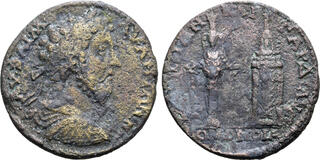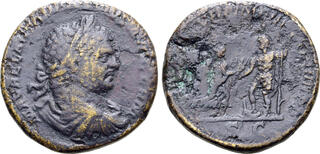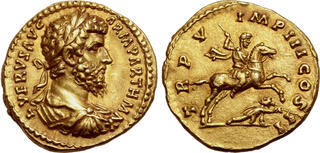Lot description:
Diocletian AV Aureus. Siscia, AD 286. IMP C DIOCLETIANVS P F AVG, laureate, draped and cuirassed bust to right / IOVI CONSERVATORI, Jupiter standing facing, head to left, nude but for chlamys on back, holding long sceptre in left hand and thunderbolt in right. RIC V.2 247; C. 149; Depeyrot 1/2 (this coin). 5.37g, 20mm, 12h.
Near Mint State. Extremely Rare; no other examples offered at auction in the past 20 years.
This coin cited in G. Depeyrot, Les monnaies d'or (Wetteren, 1995-1996);
Ex Hess-Divo AG, Auction 328, 22 May 2015, lot 268 (hammer: CHF 26,000);
Ex Münzen und Medaillen AG Basel, Auction 43, 12 November 1970, lot 437.
It would ultimately be religious legitimisation, not military achievements, that would elevate Diocletian above his predecessors. The quasi-republican ideals of Augustus' 'primus inter pares' system were abandoned for all but the tetrarchs themselves. Diocletian took to wearing a gold crown and jewels, and forbade the use of purple cloth to all but the emperors. His subjects were required to prostrate themselves in his presence (adoratio); the most fortunate were allowed the privilege of kissing the hem of his robe (proskynesis). The reverse of this coin further alludes to the quasi-divine aspects of the new 'dominate' system of government. Around 287 Diocletian assumed the title Iovius, and his colleague Maximian assumed the title Herculius; these grandiose new titles not only reflected the working dynamic between Diocletian and Maximian (while the one acted as supreme strategist, the other enforced imperial will by brute force), but more importantly by taking on divine attributes Diocletian intended to make the person of the emperor inviolate as the gods' representative on earth.
Diocletian's administrative and bureaucratic reforms encompassed far more than the decentralisation of imperial power. Some of his most enduring changes were to the Roman military. Instituting systematic annual conscription for the first time since the days of the Republic, Diocletian increased the overall size of the Roman army by roughly 33%, and more than doubled the number of legions and auxiliary units by creating smaller, more mobile detachments. A massive upgrade of the empire's defensive infrastructure was undertaken across great swathes of the borders including new fortifications and roads. Centralised fabricae were introduced to provide arms and armour for the army on an industrial scale. The most significant change to the Roman military structure was the establishment of large personal escort armies (comitatus praesentales) which typically comprised 20-30,000 elite palatine troops. These highly mobile armies were designed to quickly reinforce the border defences or crush potential usurpers. Indeed, while they proved highly effective during Diocletian's reign, in his retirement he would live to see them misused by his successors, who now each had a substantial comitatus at their disposal to enforce their claims.
Estimate: 10000 GBP |  |










